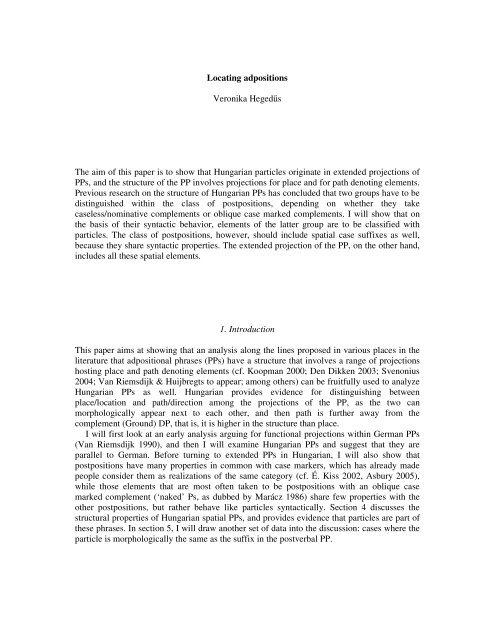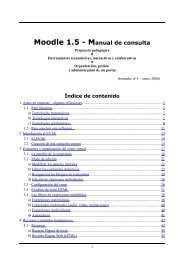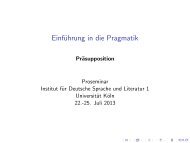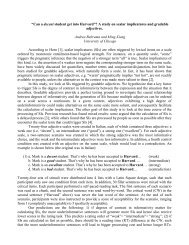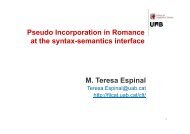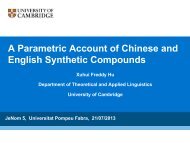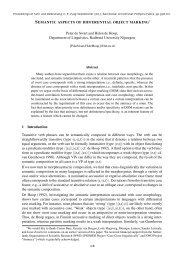Locating adpositions. - corpora@parles.upf
Locating adpositions. - corpora@parles.upf
Locating adpositions. - corpora@parles.upf
Create successful ePaper yourself
Turn your PDF publications into a flip-book with our unique Google optimized e-Paper software.
<strong>Locating</strong> <strong>adpositions</strong><br />
Veronika Hegeds<br />
The aim of this paper is to show that Hungarian particles originate in extended projections of<br />
PPs, and the structure of the PP involves projections for place and for path denoting elements.<br />
Previous research on the structure of Hungarian PPs has concluded that two groups have to be<br />
distinguished within the class of postpositions, depending on whether they take<br />
caseless/nominative complements or oblique case marked complements. I will show that on<br />
the basis of their syntactic behavior, elements of the latter group are to be classified with<br />
particles. The class of postpositions, however, should include spatial case suffixes as well,<br />
because they share syntactic properties. The extended projection of the PP, on the other hand,<br />
includes all these spatial elements.<br />
1. Introduction<br />
This paper aims at showing that an analysis along the lines proposed in various places in the<br />
literature that adpositional phrases (PPs) have a structure that involves a range of projections<br />
hosting place and path denoting elements (cf. Koopman 2000; Den Dikken 2003; Svenonius<br />
2004; Van Riemsdijk & Huijbregts to appear; among others) can be fruitfully used to analyze<br />
Hungarian PPs as well. Hungarian provides evidence for distinguishing between<br />
place/location and path/direction among the projections of the PP, as the two can<br />
morphologically appear next to each other, and then path is further away from the<br />
complement (Ground) DP, that is, it is higher in the structure than place.<br />
I will first look at an early analysis arguing for functional projections within German PPs<br />
(Van Riemsdijk 1990), and then I will examine Hungarian PPs and suggest that they are<br />
parallel to German. Before turning to extended PPs in Hungarian, I will also show that<br />
postpositions have many properties in common with case markers, which has already made<br />
people consider them as realizations of the same category (cf. É. Kiss 2002, Asbury 2005),<br />
while those elements that are most often taken to be postpositions with an oblique case<br />
marked complement (‘naked’ Ps, as dubbed by Marácz 1986) share few properties with the<br />
other postpositions, but rather behave like particles syntactically. Section 4 discusses the<br />
structural properties of Hungarian spatial PPs, and provides evidence that particles are part of<br />
these phrases. In section 5, I will draw another set of data into the discussion: cases where the<br />
particle is morphologically the same as the suffix in the postverbal PP.
<strong>Locating</strong> <strong>adpositions</strong> 17<br />
2. German circumpositional phrases<br />
Van Riemsdijk (1990) gives an analysis of German PPs and argues for positing a functional<br />
projection on top of the lexical PP in German circumpositional phrases, hosting postpositional<br />
elements. Van Riemsdijk calls this projection pP on analogy to vP and other functional<br />
extensions of lexical phrases. In German, this projection hosts elements expressing direction,<br />
orientation or proximity. This is illustrated in the examples in (1) taken from Van Riemsdijk<br />
(1990).<br />
(1) auf den Berg herauf (on the mountain up(+P)) acc<br />
auf mich zu (towards me to) acc<br />
unter der Brücke durch (under the bridge through) dat<br />
(Van Riemsdijk, 1990:233)<br />
The postpositional element in these phrases is the functional P. This postpositional element is<br />
separable from the PP, sometimes it gets incorporated into the verb in the clause. As the<br />
example in (2b) shows, the postposition can be incorporated into the main verb of the clause,<br />
and then it does not form a constituent with the rest of the pP (as opposed to the sentence in<br />
(2a)).<br />
(2) a. ...dass er auf den Berg hinauf hat steigen wollen<br />
…that he onto the mountain up has climb wanted<br />
b. …dass er auf den Berg hat hinaufsteigen wollen<br />
…that he onto the mountain has up-climb wanted<br />
(Van Riemsdijk, 1990:234)<br />
Since the postposition often does not form a constituent with the PP and since it behaves as a<br />
particle, the question arises if they really do form a pP in the first place. Van Riemsdijk<br />
(1990) uses various constituency tests to show that the postposition/particle belongs to the PP:<br />
the circumpositional phrase can be complement/adjunct to nominals (as shown in (3)), it can<br />
be a complement to prepositions (like in (4)), and the whole phrase can move together (see<br />
the topicalization example in (5)).<br />
(3) der Weg [ins Tal hinunter]<br />
the way into-the valley down<br />
(4) bis [in die Niederungen hinunter]<br />
until in the lowlands down<br />
(5) [Auf dem Turm oben] steht ein grosses Kreuz.<br />
on the tower up stands a large cross<br />
(Van Riemsdijk, 1990:234–235)<br />
That is, the constituency of the pP can be tested. As for the word order, the lexical PP is head<br />
initial in German, while pP is head-final. The surface order is assumed to be the base<br />
generated order in Van Riemsdijk (1990), but it is a derived order in Den Dikken (2003) from<br />
an underlying head-initial structure.
18<br />
Veronika Hegeds<br />
This analysis was an early proposal for adpositional phrases being analyzed in terms of<br />
functional projections on top of the lexical PP. Since then, much work has been devoted to<br />
giving a fine-grained analysis for the structure of spatial PPs based on data from various<br />
languages. Analyses of PPs following this line of thought distinguish between separate<br />
projections for at least Location/Place and Direction/Path, like Svenonius (2004) or Van<br />
Riemsdijk & Huijbregts (to appear), but sometimes a range of additional functional structure<br />
is proposed, like in Koopman (2000) or Den Dikken (2003).<br />
3. Hungarian postpositions 1<br />
Hungarian has postpositional elements, and many of them have spatial meanings. Besides<br />
postpositions, oblique case suffixes are also used to express spatial relations. Diachronically,<br />
most of the postpositions and oblique case suffixes originated in possessive constructions,<br />
where the possessum developed into a postposition, and then some of the postpositions lost<br />
their morphological independence and became suffixes (Kiss & Pusztai 2003). This change is<br />
illustrated in (6): in the first stage, the possessum is a case-marked nominal, which later<br />
develops into a postposition. At the stage when it becomes a postposition, the original case<br />
marking is no longer transparent, but the postposition itself has a spatial meaning. In the final<br />
stage, the postposition becomes a suffixal element, its form is phonetically reduced (it is<br />
mostly monosyllabic) and it also participates in vowel harmony.<br />
(6) ház bele-n > ház ben > ház-ban<br />
house inside-at house in house-INE<br />
‘at (the) inside of (the) house’ >> ‘in (the) house’<br />
An important property of these spatial elements is that they often have three related forms<br />
corresponding to locative (‘at’), lative (‘to’) and ablative (‘from’) meanings. This goes back<br />
to their nominal origin, when the nouns were bearing locative case markers expressing these<br />
relations. The three forms are illustrated in (7) where the first one of each pair contains a<br />
postposition and the second a case suffix. 2<br />
(7) a. a ház mellett a.’ a ház-ban<br />
the house beside.at the house-INE<br />
‘beside the house’<br />
‘in the house’<br />
b. a ház mellé b.’ a ház - ba<br />
the house beside.to’ the house-ILL<br />
‘(to) beside the house’<br />
‘into the house’<br />
c. a ház melll c.’ a ház - ból<br />
the house beside.from the house-ELA<br />
‘from beside the house’<br />
‘out of the house’<br />
1 The abbreviations used in the examples are the following: ACC = accusative; ADE = adessive (‘at’); ALL =<br />
allative (‘to’); DAT = dative; ELA = elative (‘out of’); ILL = illative (‘into’); INE = inessive (‘in’); INSTR =<br />
instrumental (‘with’); SUB = sublative (‘onto’); and SUP = superessive case (‘on’); PRT stands for particle.<br />
2 In those examples where the distinction seems important, I will gloss postpositions in a way that it indicates<br />
which one of the three forms they are, but it is important to note that they are synchronically no longer<br />
decomposable into the nominal stem and locative suffix that these glosses suggest.
<strong>Locating</strong> <strong>adpositions</strong> 19<br />
Some of the space-denoting elements became verbal particles through history. In neutral<br />
sentences, we find particles in the preverbal position in the clause, where they form a complex<br />
predicate with the verb in order to express complex events (É. Kiss 2004). 3 Their semantic<br />
contribution is most often telicizing. This is what led linguists to treat them as aspectual<br />
elements that have to occupy some aspectual position in the clause (É. Kiss 1998, 2002). É.<br />
Kiss (2004), however, modifies her earlier analysis by hypothesizing a predicative head where<br />
particles, as well as other predicative phrases (for example non-referential bare nouns and<br />
focused phrases), move, and thus, she derives their aspectual semantic contribution from the<br />
telicizing effect of resultative predicates.<br />
Postpositions have been argued to be of two types (‘dressed’ and ‘naked’, see the<br />
discussion below) and to be a distinct category from case suffixes. Moreover, though the<br />
particles have been related to postpositions (both historically and semantically), their syntactic<br />
relations have not been discussed much in the literature (but see Kiefer and Ladányi 2000 or<br />
É. Kiss 2002). In this section, I will discuss the main topics that have been around related to<br />
PPs and the classification of spatial elements, and propose that ‘naked’ Ps should be treated<br />
on a par with particles, while postpositions and locative case suffixes behave very similarly,<br />
both of them are of category P.<br />
3.1. ‘Dressed’ versus ‘naked’ Ps<br />
Marácz (1985, 1986, 1989) distinguishes between ‘dressed’ Ps and ‘naked’ Ps in Hungarian:<br />
‘dressed’ Ps are those that take a nominative (Marácz 1989)/caseless (É. Kiss 2002)<br />
complement, while ‘naked’ Ps appear with oblique case-marked complements. 4 In fact, the<br />
distinction between these two types is older (cf. Sebestyén 1965 for discussion and<br />
references), but the systematic study in modern linguistic terms and the names of the two<br />
groups are due to Marácz (1985, 1986). The examples in (8) illustrate the two types of<br />
postpositions.<br />
(8) a. a híd alatt (‘dressed’ P)<br />
the bridge under.at<br />
‘under the bridge’<br />
b. a híd – on át (‘naked’ P)<br />
the bridge-SUP across<br />
‘across the bridge’<br />
There are further differences between the two groups: ‘dressed’ Ps got their name because<br />
they bear an agreement marker (Marácz 1985, 1986), that is, they are inflected for number<br />
and person, when their complement is pronominal (cf. (9a)). ‘Naked’ Ps, however, never<br />
show agreement. Instead, the case marker on their complement is the agreeing element (as<br />
(9b) shows). The pronominal complement can be a pro in both cases.<br />
3 Sentences with flat prosody comprise neutral sentences, as opposed to non-neutral sentences, which contain<br />
a constituent (focus, wh-phrase, negation) bearing extra stress and thus eradicating other main stress in the clause<br />
(cf. Kálmán, 1985).<br />
4 Since Marácz (1989) assumes that Ps are case-assigners, he takes ‘dressed’ Ps to assign nominative case<br />
(which is morphologically zero in Hungarian). É. Kiss (2002), however, relates Ps to case markers, thus she<br />
considers the complements of ‘dressed’ Ps to be caseless.
20<br />
Veronika Hegeds<br />
(9) a. (én)mögött –em (‘dressed’ P)<br />
I behind.at-1sg<br />
‘behind me’<br />
b. (én)vel -em szemben (‘naked’ P)<br />
I INSTR-1sg opposite<br />
‘opposite me’<br />
It seems then that in this respect, it is rather the ‘dressed’ P and the oblique case marker on the<br />
complement of the ‘naked’ P that behave similarly and not the two types of Ps. I will return to<br />
this point when discussing case suffixes and postpositions.<br />
Another difference between ‘dressed’ Ps and ‘naked’ Ps lies in their ordering possibilities<br />
with respect to their complements. ‘Dressed’ Ps must always immediately follow their<br />
complement, but ‘naked’ Ps may also precede it, as can be seen in the contrast between (10a)<br />
and (10b).<br />
(10) a. *alatt a híd (‘dressed’ P)<br />
under.at the bridge<br />
b. át a híd- on (‘naked’ P)<br />
across the bridge-SUP<br />
Also, when there is a modifier in the PP, it cannot appear between the complement and a<br />
‘dressed’ P, but it may be between a ‘naked’ P and its complement. As (11a) shows, the<br />
modifier has to precede the complement in the case of ‘dressed’ Ps but it can appear both<br />
before and after the complement as can be seen in (11b).<br />
(11) a. (egyenesen) a híd (*egyenesen) alá (‘dressed’) P<br />
straight the bridge straight under.to<br />
‘straight (to) under the bridge’<br />
b. (egyenesen) a híd-on (egyenesen) át (‘naked’ P)<br />
straight the bridge-SUP straight across<br />
‘straight across the bridge’<br />
As Marácz (1986) already noted, all and only ‘naked’ Ps seem to be able to appear without a<br />
nominal complement, but in these cases we are dealing with particles according to Marácz<br />
(1989) and not with postpositions. Marácz (1989) analyzes those cases where it seems that the<br />
‘naked’ P has been separated from its complement (or where it has no complement) and is in<br />
the verb modifier position as structures involving particles, which is a different category. That<br />
is, the preverbal element is a particle; and the particle and the verb together govern the<br />
oblique case marked argument in (12b)<br />
(12) a. János át ment.<br />
John across went<br />
‘John went across/over.’<br />
b. János át ment a híd -on.<br />
John across went the bridge-SUP<br />
‘John went across the bridge.’
<strong>Locating</strong> <strong>adpositions</strong> 21<br />
Thus, on the basis of their behavior, we can conclude that ‘naked’ Ps are rather different from<br />
‘dressed’ Ps. 5 É. Kiss (1999, 2002) argues for making the class of Ps more homogeneous, and<br />
eliminates most of the group of ‘naked’ Ps by assigning the members to various other classes<br />
(particles, adverbs, participles) on the basis of their different behavior. I will follow this line<br />
of thought and propose that it is worth extending the proposal that ‘naked’ Ps are sometimes<br />
particles (proposed by Marácz 1989) to all cases, that is, to say that there are no ‘naked’ Ps;<br />
these elements – at least the spatial ones – are particles. 6 In fact, in the light of the proposal<br />
below related to the structure of extended PPs in Hungarian, this seems to be a logical move.<br />
In section 4, I will argue that in examples like (10b), át ‘across’ is a particle, but contrary to<br />
general assumptions, it does form a constituent with the postverbal PP at some point during<br />
the derivation.<br />
Before turning to the particles, however, I will first discuss another class of elements and<br />
their relationship to postpositions, and this is the class of spatial suffixes in Hungarian.<br />
3.2. Postpositions and case suffixes<br />
As has already been mentioned, Hungarian oblique case suffixes developed from<br />
postpositions. Arguments for their different grammatical status mostly mention that suffixes<br />
take part in vowel harmony, they cannot take further inflections, and they behave differently<br />
in elliptical co-ordination structures. These differences led Marácz (1989) to consider<br />
postpositions and case suffixes to be fundamentally different categories with P being a caseassigning<br />
category. On the other hand, there are various properties that case suffixes share<br />
with ‘dressed’ Ps, which makes it hard to distinguish between the two classes of elements.<br />
This was already pointed out in the strucutralist literature by Antal (1961), and was recently<br />
also argued for in É. Kiss (2002) and Asbury (2005).<br />
I will follow É. Kiss (2002) and Asbury (2005) in assuming that the differences between<br />
oblique case suffixes and postpositional elements result from the suffixal nature of some of<br />
the elements and the morphologically slightly more independent behavior of others, but<br />
ultimately, postpositions and case suffixes are instantiations of the same category, which I<br />
take to be the category of <strong>adpositions</strong>.<br />
First of all, they share semantic properties in that both case suffixes and postpositions can<br />
express spatial relations, and whether a certain meaning is encoded by a suffixal element or<br />
by a postposition seems purely accidental. Also, they share the property of having three<br />
related forms corresponding to locative, lative and ablative meanings, as illustrated in the<br />
examples in (7).<br />
Syntactically, ‘dressed’ postpositions and case suffixes behave in the same way. Their<br />
order with respect to the complement is equally fixed: they always immediately follow their<br />
complement and can never precede it (in this respect, they are both different from ‘naked’<br />
postpositions, see the discussion related to (10) in section 3.1.).<br />
(13) a. *alatt a híd<br />
under.at the bridge<br />
‘under the bridge<br />
5 It is not so surprising given that their historical origins are also different as many of them developed in<br />
appositive structures and not in possessive constructions (cf. Kiss & Pusztai 2003).<br />
6 That ‘naked’ Ps are more like particles was also suggested by Den Dikken (2004). The claim that they are<br />
all particles, however, has certain predictions about their distribution that still needs to be tested.
22<br />
Veronika Hegeds<br />
b. *ra a híd<br />
SUB the bridge<br />
‘onto the bridge’<br />
Moreover, their forms next to pronominal complements look the same as well. We have<br />
already seen in the examples in (9) that ‘dressed’ and ‘naked’ Ps behave differently, and it is<br />
the case marker in the complement of ‘naked’ Ps that is similar to ‘dressed’ Ps. What we can<br />
observe is that the pronominal form is created by adding an agreement suffix to the<br />
postposition / case marker. This is again illustrated in (14).<br />
(14) a. (én)mögött-em<br />
I behind.at-1sg<br />
‘behind me’<br />
b. (én)nál-am<br />
I ADE-1sg<br />
‘at me’<br />
‘Dressed’ Ps and case suffixes also exhibit the same structure in demonstrative constructions:<br />
both of them are ‘reduplicated’ on the demonstrative pronoun, as illustrated in (15).<br />
(15) a. az alatt a híd alatt<br />
that under the bridge under<br />
‘under that bridge’<br />
b. az -on a híd-on<br />
that-SUP the bridge-SUP<br />
‘on that bridge’<br />
As is expected, in the case of ‘naked’ Ps, the oblique suffix reduplicates on the demonstrative,<br />
supporting further the view to take postpositional elements and case suffixes as instantiations<br />
of the same category, and to treat ‘naked’ Ps as different from the other two.<br />
(16) az - on a híd-on át<br />
that-SUP the bridge-SUP across<br />
‘across that bridge’<br />
Eventually, every syntactic account of PPs has to be able to deal with this phenomenon of P-<br />
reduplication on the demonstrative, but this is beyond the scope of this paper. What these<br />
examples are meant to emphasize is that when it comes to syntactic properties, postpositions<br />
and case suffixes behave very much alike. This gives an additional argument for treating these<br />
two on a par, and not ‘dressed’ and ‘naked’ Ps, since ‘naked’ Ps show none of these<br />
properties but share properties with particles. I will turn to these elements now.<br />
3.3. Postpositions and particles<br />
Many of the particles in Hungarian are spatial, but some of them seem to have lost their<br />
original spatial meaning and now function purely as telicizers (Kiefer 1992). Spatial particles
<strong>Locating</strong> <strong>adpositions</strong> 23<br />
are directional or locative, and although the locative ones are not always classified as particles<br />
(but as adverbs), they show similar behavior as directional ones.<br />
Particles are most often in the preverbal position in neutral sentences. They move there in<br />
order to form a complex predicate with the verb. In É. Kiss’ (2004) analysis, particles (just<br />
like other predicative elements and focused constituents) move to a Predicate Phrase on top of<br />
the VP.<br />
(17) a A könyv le- esett.<br />
the book down fell<br />
‘The book fell down.’<br />
b. Mari fel-olvasta a level-et.<br />
Mary up-read the letter-ACC<br />
‘Mary read out the letter.’<br />
c. Mari fel-mászott a hegy-re.<br />
Mary up-climbed the hill-SUB<br />
‘Mary climbed up the hill.’<br />
As can be seen in the examples in (17), particles can be used in similar contexts in Hungarian<br />
as in English. However, we find not only a directional particle in (17c), but also a (suffixal)<br />
postposition that expresses a spatial relation.<br />
Sentences that contain a particle and a spatial PP have been mostly regarded as cases<br />
where the complex verb formed by the particle and the verb take a PP/oblique DP (cf. Kiefer<br />
1992). Below, I will argue that in these cases, the particle actually originates in the postverbal<br />
pP.<br />
4. Hungarian pPs<br />
As in German, it is also often the case in Hungarian that the PP in the clause is somehow<br />
associated with a particle in the preverbal position.<br />
(18) Az egér be-szaladt az ágy alá.<br />
the mouse into-ran the bed under.to<br />
‘The mouse ran under the bed.’ (directional)<br />
These structures are quite similar to the German ones (cf. the examples in (2)). It seems to be<br />
the case that the original structure is also like in German in that the particle does originate in<br />
the extended PP, but is moved out. That is to say, Hungarian also exhibits pPs, and the<br />
structure of the pP is very similar to the German ones, but the order is the mirror image, as<br />
can be seen in (19) and (20).<br />
(19) [ pP [ PP unter der Brücke] durch]<br />
under the bridge through<br />
(20) [ pP át [ PP a híd alatt]]<br />
through the bridge under.at
24<br />
Veronika Hegeds<br />
There is a prepositional pP, and a postpositional PP; the functional projection expresses<br />
orientation, directionality, and/or proximity. This is illustrated in the following examples.<br />
(21) a. lent a völgy-ben<br />
down the valley-INE<br />
‘down in the valley’<br />
b. be az ágy alá<br />
into the bed under.to<br />
‘(to) under the bed’<br />
c. ide hoz-zám<br />
here ALL-1sg<br />
‘here to me’<br />
Again, constituency tests can be used to show that the particle and the PP do form a<br />
constituent: the pP can appear next to nominals as in (22), it can move as a constituent for<br />
example as contrastive topic (cf. (23)), it can be used as an answer (see (24)), and it can be<br />
used as the first constituent in the PP-with-DP construction (as in (25)), which is an<br />
environment where we only find directional PPs.<br />
(22) a csatorna [lent a város alatt]<br />
the tunnel down the city under.at<br />
‘the tunnel under the city’<br />
(23) [Lent a pincé-ben] nem maradt már semmi.<br />
down the cellar-INE not remained yet nothing.<br />
‘Down in the cellar, nothing is left.’<br />
(24) Hová szaladt az egér?<br />
where ran the mouse<br />
‘Where did the mouse run?’<br />
[Be az ágy alá.]<br />
into the bed under.to<br />
‘Under the bed.’<br />
(25) [ Le a pincé-be] az üres üvegek-kel!<br />
down the cellar-ILL the empty bottles-INSTR<br />
‘Down to the cellar with the empty bottles!’<br />
The tests show that spatial particles start out forming a constituent with the PPs. This,<br />
however, is often concealed by the fact that the particles obligatorily move to the preverbal<br />
position during the derivation, as we saw earlier.<br />
However, when the pP is an adjunct, the movement to the preverbal position does not have<br />
to take place, and we attest a lot of cases where the particle and the rest of the PP form a<br />
constituent. This is the case in (26), where the adjunct pP is focus, or in (27), where it remains<br />
in postverbal position.
<strong>Locating</strong> <strong>adpositions</strong> 25<br />
(26) A kedvenc lemezem-et [csak fent a padlás-on] talált-am meg.<br />
the favorite record-ACC only up the attic-SUP found-1sg PRT<br />
‘I only found my favorite record (up) in the attic.’<br />
(27) János gyakorolta a tolatás-t [ki a garázs-ból]<br />
John practised the reversing-ACC out the garage-ELA<br />
és [be a ház mögé].<br />
and into the house behind.to<br />
‘John practised reversing out of the garage and (to) behind the house.’<br />
Thus, these examples and the tests support the claim that the particles originate in pPs in<br />
Hungarian. This means that the structure suggested for other languages where we find several<br />
projections within the PP applies for Hungarian as well: that is, we expect to find locative and<br />
directional PPs, which we have already seen to be the case. It is also the case that when<br />
location/place and direction/path appear together in one phrase, direction/path is higher in the<br />
structure. This can be seen in the following example, where the locative postposition bears a<br />
directional suffix. 7<br />
(28) a a ház mögött -re<br />
the house behind.at-SUB<br />
‘(to) behind the house’<br />
b. [ PathP [ PlaceP [ DP a ház] mögött] –re]<br />
That is, it is not enough to posit that particles are a part of the extended PP and head their own<br />
(functional) projection, we further have to distinguish between locative and directional<br />
projections within this extended PP. This can be done in the way illustrated in (28b) by<br />
splitting the PP into PlaceP and PathP. It implies, then, that apart from the pP layer in the<br />
structure (hosting particles), we have to postulate a richer structure in the PP part of Van<br />
Riemsdijk’s (1990) structure as well. Whether the structure in (28b) is enough to derive all<br />
ordering possibilities in Hungarian is not clear at the moment. Providing a detailed analysis of<br />
the actual structure of Hungarian spatial PPs is left for future research.<br />
5. More pPs in Hungarian?<br />
The sentences discussed so far contained a preverbal particle and a related PP (generally in<br />
the postverbal part of the clause). I was claiming that in these cases the particle originates in<br />
the extended pP. Another construction that seems obviously related is the one in (29):<br />
7 These examples are not so frequent, however, because there is a competing form to express the same<br />
directional meaning and that is with the use of the directional form of the postposition as in (i).<br />
(i) a ház mögé<br />
the house behind.to<br />
‘(to) behind the house’<br />
In (i), the lative form of the postposition is used instead of the locative one (with an additional sublative suffix),<br />
and this is the more frequent way of expressing the relevant meaning. The phrase in (24) has a bit of a special<br />
meaning in that the spatial meaning of the postposition is more transparent, and thus, the phrase means rather<br />
something like ‘to the space behind the house’.
26<br />
Veronika Hegeds<br />
(29) a. János bel- e –ugrott a medencé-be.<br />
John into-agr-jumped the pool - ILL<br />
‘John jumped into the pool.’<br />
b. Mari hoz-zá- vágta a tányér-t a fal-hoz.<br />
Mary to-agr-threw the plate-ACC the wall-ALL<br />
‘Mary threw the plate at the wall.’<br />
These sentences also contain a directional particle and a postverbal PP, where it seems to be<br />
important that the P is realized by a suffix. The difference is that the preverbal particle is<br />
morphologically the ‘reduplication’ of the suffix, that is, contrary to the examples discussed<br />
in the previous sections, the particle seems to express exactly the same meaning as the<br />
suffixal P. Furthermore, the particle bears an agreement marker that on first sight seems to<br />
express agreement with the complement of the postverbal P-suffix.<br />
É. Kiss (2002) considers the possibility that the particle in these sentences is derivationally<br />
related to the PP (with the complement extracted and the particle subsequently moved to the<br />
preverbal position) to account for the agreement, but then rejects this option and analyzes<br />
these cases as involving a preverbal PP co-indexed with a postverbal PP. It is the coindexation<br />
between the two PPs that is responsible for the reduplicative property and for the<br />
apparent possessive agreement marking as well.<br />
The problem with this analysis is that despite the apparent agreement marker on the<br />
preverbal particle, it is not possible to have plural agreement when the complement of the<br />
postverbal PP is plural (as also pointed out by É. Kiss 1998). That is, examples like (30) are<br />
ungrammatical.<br />
(30) a. *János belé-jük ugrott a medencék-be.<br />
John into-3pl jumped the pools-ILL<br />
‘John jumped into the pools.’<br />
b. *Mari hozzá-juk vágta a tányérok-at a többiek-hez.<br />
Mary to - 3pl threw the plates-ACC the others-ALL<br />
‘Mary threw the plates at the others.’<br />
If the particle were co-indexed with the postverbal PP and thus showed agreement with its<br />
complement, it should be possible to mark it for the plural. But it is not, and I believe this is<br />
because the two are not in the relationship that is assumed by É. Kiss (2002).<br />
I assume that we are faced with the same construction here as in the previous section. É.<br />
Kiss’s (1998) earlier analysis also takes the preverbal elements to be genuine particles, but I<br />
would also like to extend the analysis along the lines of extended PPs to these constructions,<br />
that is, to say that these particles also originate in the postverbal PP. It is not so easy,<br />
however, to prove this point. While in the previous examples we could find various<br />
constituency tests to show that the particle and the PP form a constituent, here the only<br />
constituency test that seems to work is the PP-with-DP construction. As can be seen in (31),<br />
even these constructions are not always fully grammatical, or at least they feel awkward and<br />
rather redundant.<br />
(31) a. ?[Bel-e a medencé-be] a gyerekek-kel!<br />
into-agr the pool – ILL the children-INSTR<br />
‘Into the pool with the children!’
<strong>Locating</strong> <strong>adpositions</strong> 27<br />
b. [Nek-i a ház-nak] a bulldózer-rel!<br />
to-agr the house-DAT the bulldozer-INSTR<br />
‘Into the house with the bulldozer!’<br />
It is still necessary to test the grammaticality of these constructions with all the possible<br />
particles and see what may be behind the difference in acceptability among these sentences,<br />
but the fact that the examples in (27) are not ungrammatical seems to suggest that we are<br />
really dealing with the same kind of structure as in the cases where the particle does not have<br />
an agreement marker, that is, the particle originates in the PP.<br />
6. Conclusions<br />
I have shown in this paper that Hungarian PPs can be fruitfully analyzed in terms of extended<br />
structures involving projections that host particles. Various constituency tests support the<br />
claim that in sentences where a preverbal particle is semantically related to a PP in Hungarian,<br />
the particle actually forms a constituent with the PP at some stage of the derivation.<br />
I also discussed the problems related to the classification of various spatial elements in<br />
Hungarian, and showed that some earlier assumptions should be abandoned. On the one hand,<br />
the distinction between ‘dressed’ and ‘naked’ postpositions reflects a difference between<br />
postpositions and particles, since they show rather different syntactic behavior, and ‘naked’ Ps<br />
behave more like particles. One the other hand, ‘dressed’ Ps share various properties with<br />
spatial case suffixes, so these two categories should be treated as instantiations of the same<br />
underlying category, they are both postpositions.<br />
Veronika Hegeds<br />
Tilburg University<br />
v.hegedus@uvt.nl<br />
References<br />
Antal, L. (1961). A magyar esetrendszer. [The Hungarian Case System], Akadémiai Kiadó, Budapest.<br />
Asbury, A. (2005). Adpositions as case realizations. In Salzmann M. & L. Vicente (eds.) Leiden Papers in<br />
Linguistics. pp. 69-92.<br />
den Dikken, M. (2003). On the syntax of locative and directional adpositional phrases. Ms.<br />
den Dikken, M. (2004). The syntax of adpositional phrases. LOT Winter School course 2004, Amsterdam.<br />
É. Kiss, K. (1998) Verbal Prefixes or Postpositions? Postpositional Aspectualizers in Hungarian. In Kenesei I.<br />
(ed.) Approaches to Hungarian Vol. 6. Papers from the Amsterdam Conference. JATE, Szeged, pp. 123-148.<br />
É. Kiss, K. (1999). Mi tartozik a névutók osztályába? [What belongs to the class of postpositions?] Magyar<br />
nyelvjárások 37, pp. 167-172.<br />
É. Kiss, K. (2002). The Syntax of Hungarian. Cambridge University Press, Cambridge.<br />
É. Kiss, K. (2004). Egy igekötelmélet vázlata. [Outline of a theory of the verbal particle] Magyar nyelv 50, pp.<br />
15-43.<br />
Kálmán, L. (1985). Word Order in Neutral Sentences. In Kenesei I. (ed.) Approaches to Hungarian 1. JATE,<br />
Szeged, pp. 13-23.<br />
Kiefer, F. (1992). Az aspektus és a mondat szerkezete. [Aspect and the structure of the clause] In Kiefer, F. (ed.)<br />
Strukturális magyar nyelvtan 1. Mondattan [Structural Hungarian Grammar 1. Syntax], Akadémiai Kiadó,<br />
Budapest, pp. 797-886.<br />
Kiefer, F. & Ladányi, M. (2000). Az igekötk. [Particles] In Kiefer, F. (ed.) Strukturális magyar nyelvtan 3.<br />
Morfológia [Structural Hungarian Grammar 3. Morphology], Akadémiai Kiadó, Budapest, pp. 453-518.<br />
Kiss, J. & Pusztai, F. eds. (2003). Magyar nyelvtörténet. [Hungarian language history] Osiris Kiadó, Budapest.
28<br />
Veronika Hegeds<br />
Koopman, H. (2000). ‘Prepositions, postpositions, circumpositions, and particles. The structure of Dutch PPs’.<br />
In Koopman H. (ed.) The Syntax of Specifiers and Heads. Routledge, London, pp. 204-260.<br />
Marácz, L. (1985). A magyar névutós csoportról. [On the Hungarian Postpositional Phrase] Nyelvtudományi<br />
Közlemények 87, pp. 173-180.<br />
Marácz, L. (1986). Dressed or Naked: The Case of the PP in Hungarian. In Abraham, W. & S. de Meij (eds.)<br />
Topic, Focus and Configurationality, John Benjamins, Amsterdam/Philadelphia, pp. 227-252.<br />
Marácz, L. (1989). Asymmetries in Hungarian. Rijksuniversiteit Groningen: PhD dissertation.<br />
Riemsdijk, H. C. van. (1990). Functional prepositions. In Pinkster, H. & I. Genee (eds.) Unity in diversity:<br />
papers presented to Simon C. Dik on his 50th birthday. Foris, Dordrecht, pp. 229-241.<br />
Riemsdijk, Henk C. van, & Huijbregts, R. (to appear). Location and Locality. In: Festschrift to Joseph Emonds.<br />
Mouton de Gruyter.<br />
Sebestyén, Á. (1965). A magyar nyelv névutórendszere. [The system of postpositions in the Hungarian language]<br />
Akadémiai Kiadó, Budapest.<br />
Svenonius, P. (2004). ‘Spatial prepositions in English’. Ms. University of Tromsø; available at<br />
http://ling.auf.net/lingBuzz/000001.


